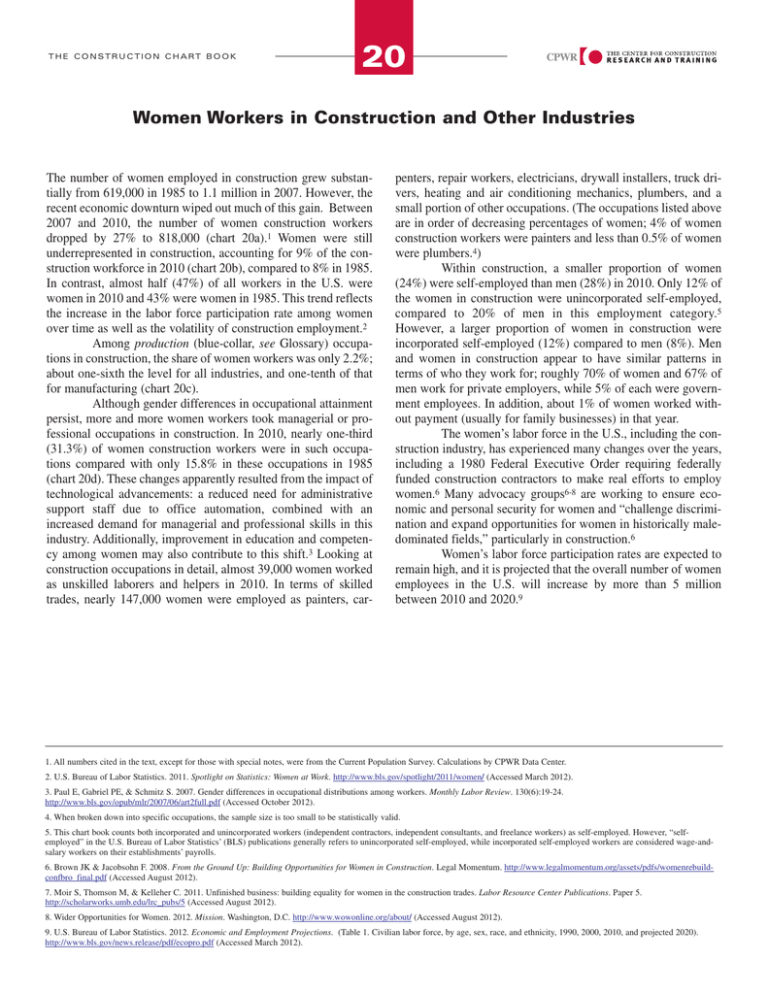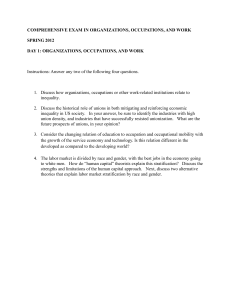Pages as PDF
advertisement

THE CONSTRUCTION CHART BOOK 20 Women Workers in Construction and Other Industries The number of women employed in construction grew substantially from 619,000 in 1985 to 1.1 million in 2007. However, the recent economic downturn wiped out much of this gain. Between 2007 and 2010, the number of women construction workers dropped by 27% to 818,000 (chart 20a).1 Women were still underrepresented in construction, accounting for 9% of the construction workforce in 2010 (chart 20b), compared to 8% in 1985. In contrast, almost half (47%) of all workers in the U.S. were women in 2010 and 43% were women in 1985. This trend reflects the increase in the labor force participation rate among women over time as well as the volatility of construction employment.2 Among production (blue-collar, see Glossary) occupations in construction, the share of women workers was only 2.2%; about one-sixth the level for all industries, and one-tenth of that for manufacturing (chart 20c). Although gender differences in occupational attainment persist, more and more women workers took managerial or professional occupations in construction. In 2010, nearly one-third (31.3%) of women construction workers were in such occupations compared with only 15.8% in these occupations in 1985 (chart 20d). These changes apparently resulted from the impact of technological advancements: a reduced need for administrative support staff due to office automation, combined with an increased demand for managerial and professional skills in this industry. Additionally, improvement in education and competency among women may also contribute to this shift.3 Looking at construction occupations in detail, almost 39,000 women worked as unskilled laborers and helpers in 2010. In terms of skilled trades, nearly 147,000 women were employed as painters, car- penters, repair workers, electricians, drywall installers, truck drivers, heating and air conditioning mechanics, plumbers, and a small portion of other occupations. (The occupations listed above are in order of decreasing percentages of women; 4% of women construction workers were painters and less than 0.5% of women were plumbers.4) Within construction, a smaller proportion of women (24%) were self-employed than men (28%) in 2010. Only 12% of the women in construction were unincorporated self-employed, compared to 20% of men in this employment category.5 However, a larger proportion of women in construction were incorporated self-employed (12%) compared to men (8%). Men and women in construction appear to have similar patterns in terms of who they work for; roughly 70% of women and 67% of men work for private employers, while 5% of each were government employees. In addition, about 1% of women worked without payment (usually for family businesses) in that year. The women’s labor force in the U.S., including the construction industry, has experienced many changes over the years, including a 1980 Federal Executive Order requiring federally funded construction contractors to make real efforts to employ women.6 Many advocacy groups6-8 are working to ensure economic and personal security for women and “challenge discrimination and expand opportunities for women in historically maledominated fields,” particularly in construction.6 Women’s labor force participation rates are expected to remain high, and it is projected that the overall number of women employees in the U.S. will increase by more than 5 million between 2010 and 2020.9 1. All numbers cited in the text, except for those with special notes, were from the Current Population Survey. Calculations by CPWR Data Center. 2. U.S. Bureau of Labor Statistics. 2011. Spotlight on Statistics: Women at Work. http://www.bls.gov/spotlight/2011/women/ (Accessed March 2012). 3. Paul E, Gabriel PE, & Schmitz S. 2007. Gender differences in occupational distributions among workers. Monthly Labor Review. 130(6):19-24. http://www.bls.gov/opub/mlr/2007/06/art2full.pdf (Accessed October 2012). 4. When broken down into specific occupations, the sample size is too small to be statistically valid. 5. This chart book counts both incorporated and unincorporated workers (independent contractors, independent consultants, and freelance workers) as self-employed. However, “selfemployed” in the U.S. Bureau of Labor Statistics’ (BLS) publications generally refers to unincorporated self-employed, while incorporated self-employed workers are considered wage-andsalary workers on their establishments’ payrolls. 6. Brown JK & Jacobsohn F. 2008. From the Ground Up: Building Opportunities for Women in Construction. Legal Momentum. http://www.legalmomentum.org/assets/pdfs/womenrebuildconfbro_final.pdf (Accessed August 2012). 7. Moir S, Thomson M, & Kelleher C. 2011. Unfinished business: building equality for women in the construction trades. Labor Resource Center Publications. Paper 5. http://scholarworks.umb.edu/lrc_pubs/5 (Accessed August 2012). 8. Wider Opportunities for Women. 2012. Mission. Washington, D.C. http://www.wowonline.org/about/ (Accessed August 2012). 9. U.S. Bureau of Labor Statistics. 2012. Economic and Employment Projections. (Table 1. Civilian labor force, by age, sex, race, and ethnicity, 1990, 2000, 2010, and projected 2020). http://www.bls.gov/news.release/pdf/ecopro.pdf (Accessed March 2012). 20 THE CONSTRUCTION CHART BOOK 20a. Number of women workers in construction, selected years, 1985-2010 (All employment) 20b. Women as a percentage of workers, by industry, 2010 (All employment) 20c. Women as a percentage of workers, selected industries, 2010 (Production occupations) 20d. Distribution of women workers in construction, by occupation type, 1985 and 2010 (All employment) Note: Chart 20c - Industries not shown in the chart include Agriculture, Mining, Finance, and Public Administration because the statistical samples were too small. Chart 20d - See page 11 for occupations. Figures are 12-month averages. Totals may not add to 100% due to rounding. Source: Charts 20a and 20d - U.S. Bureau of Labor Statistics. 2010 and previous years Current Population Survey. Calculations by CPWR Data Center. Charts 20b and 20c - U.S. Bureau of Labor Statistics. 2010 Current Population Survey. Calculations by CPWR Data Center.

